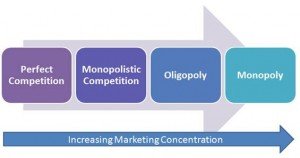Posted in Business Management, Marketing, Principles of Management
on Mar 4th, 2014 | 0 comments
Market Structure and Pricing Decisions- An overview
What is Market Structure: It is the makeup of a particular market like different characteristics, size, value, number of providers etc.

Business markets are always dynamic in nature and influenced by the number and size of potential buyers and sellers, which in turn affects the pricing of a product. If the price is set too high, say, in a homogeneous market, the firm will not be able to survive and compete with other suppliers in the market. If the price is too low, it will not be sufficient enough to cover the profit margin. If you are a monopoly player, then you are the price maker and the price you fix goes unchallenged. First let us have a glimpse on different kinds of market structure and their effect on determining the price. Four different market structures are identified.
Perfect Competition
- Consists of huge number of buyers and sellers, each too small to affect the price of the product-sellers are “price takers and not price makers.”
- Homogenous products
- Easy entry and exit to and from the market
- Agents have perfect knowledge about market conditions.
Here, the product is totally undifferentiated and the sellers always sell their product at market determined prices. Otherwise, they fail to attract their customers. Price cutting becomes unnecessary as producers can sell their total output at market price.
Monopoly
- Only one seller in the market
- Factors prevail that stops other firms from entering into the market, such as, exclusive government license, access to natural resources, patent holding, being a pioneer in the field etc.,
- The product is highly differentiated from other goods
- There must be no good substitutes
Monopolistic Competition
- Has elements of both monopoly and perfect competition
- Resembles monopoly in that, product of individual firms are slightly differentiated from others and does not serve as a perfect substitute
- Resembles perfect competition, in the sense that, there are a large number of sellers and the action of one does not have any effect on the other
- The difference lies in the fact that sellers have some control over price fixing as some customers might be willing to pay a slightly higher price if the products are differentiated from the competitors.
Oligopoly
- Involves unspecified number of buyers
- Only a small number of sellers exist
- The actions of each firm affect the other sellers in an oligopoly market
- Products are homogenous or differentiated
- To persist in the long run an oligopoly firm has to do something that prevents the entry of new firms into the market, either in the form of product differentiation or clever advertising.
- Price cutting or increase affects the sales of other firms too and so the sellers must be cautious of this interdependent characteristic of the market structure.
A clear idea and analysis of the market structure in which the firm operates, target customers, size of the firm and knowledge about competitor strategy as well as general trend of the market is helpful in formulating appropriate strategies regarding pricing and promotion of your product.